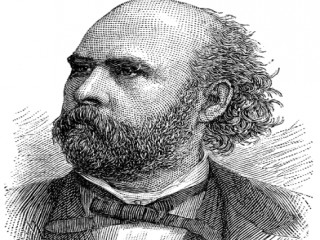
George W. Melville biography
Date of birth : 1841-01-10
Date of death : 1912-03-17
Birthplace : New York City, New York, US
Nationality : American
Category : Arhitecture and Engineering
Last modified : 2011-05-13
Credited as : Naval officer, polar adventurer and engineer, Arctic explorations
The American naval officer and polar adventurer George Wallace Melville is known for his Arctic explorations and his mechanical and engineering talents.
George Melville was born in New York City on Jan. 10, 1841. He graduated from the Brooklyn Collegiate and Polytechnic Institute and entered engineering work, but in 1861 he enlisted in the U.S. Navy and served throughout the Civil War. Remaining in the service after the war, Melville exhibited more than ordinary talent, devotion, and ambition. He volunteered in 1873 as chief engineer of the Tigress during its Arctic search for the missing Polaris and its crew.
In 1879 Melville was chief engineer aboard the Jeannette, commanded by Lt. George W. De Long, on its famous but disastrous polar voyage. Reaching the Arctic Ocean by way of Bering Strait, De Long attempted to make a deep penetration of the polar sea; instead his vessel was almost immediately enveloped by solid ice. The Jeannette drifted in its ice pack for two years and eventually was crushed and sank. The De Long party of 33 then attempted to reach land in Siberia, several hundred miles away, undergoing an incredibly arduous journey by sledge and boat. As they finally neared land, a storm separated the three boats, but Melville's boat and crew reached land safely. One crew perished at sea, while De Long's crew landed but starved before they were located. Only the two men sent on to bring help to the others survived. When Melville learned of De Long's landing from these two men, the still feeble engineer led a desperate search for De Long. After several months Melville found the last campsite and the bodies of his former shipmates. His book, In the Lena Delta (1884), is a modest, straightforward account of this exploit.
In 1887 Melville became chief of the Bureau of Steam Engineering, where he participated in the construction of a new and modern navy. He supervised the machine design for 120 ships, introducing the triple screw, the watertube boiler, the vertical engine, and the repair ship. Two of the vessels whose machinery he designed, the Columbia and the Minneapolis, held the speed record for warships for almost a decade. He also instigated a general reform of the entire naval engineering department. Designated a rear admiral in 1899, Melville retired in that grade in 1903.
Among Melville's many honors was election in 1899 as president of the American Society of Mechanical Engineers. A large, balding, full-bearded man, he presented a gruff exterior that masked an indomitable and innovative spirit. He died in Philadelphia on March 17, 1912.
















